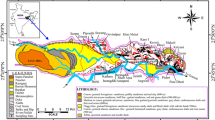Abstract.
This paper outlines general trends in the geochemistry of the more than 10,000 km of flooded underground mine workings in the Butte mining district. The waters in question range in pH from 4 to 8, are all moderately to strongly reducing, and show a huge range in concentration of dissolved metals such as Al, As, Fe, Mn, and Zn. Metal concentrations and total acidity are highest in the Kelley mine shaft, which was the main dewatering station used to pump ground water from the underground mine complex during active mining operations. In contrast, metal concentrations are much lower in the outer portions of the district where many of the mines contain hydrogen sulfide formed by sulfate-reducing bacteria. In comparison to the other heavy metals, concentrations of Pb and Cu are quite low in the flooded mine shafts. An interesting inverse correlation between pH and water temperature is noted, which may be partly caused by exothermic pyrite oxidation reactions in the central portion of the district.
Similar content being viewed by others
Author information
Authors and Affiliations
Corresponding author
Rights and permissions
About this article
Cite this article
Gammons, C.H., Metesh, J.J. & Snyder, D.M. A Survey of the Geochemistry of Flooded Mine Shaft Water in Butte, Montana. Mine Water Environ 25, 100–107 (2006). https://doi.org/10.1007/s10230-006-0117-3
Received:
Accepted:
Issue Date:
DOI: https://doi.org/10.1007/s10230-006-0117-3




